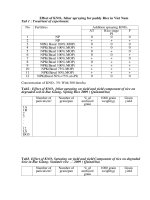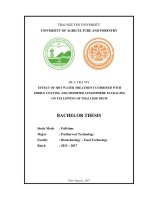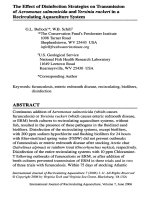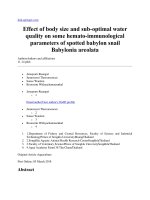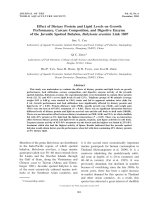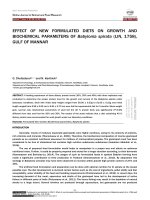Effect of extenders containing glycerol and egg yolk on motility and viability of chilled ram semen collected during non-breeding season
Bạn đang xem bản rút gọn của tài liệu. Xem và tải ngay bản đầy đủ của tài liệu tại đây (364.79 KB, 9 trang )
Int.J.Curr.Microbiol.App.Sci (2019) 8(5): 588-596
International Journal of Current Microbiology and Applied Sciences
ISSN: 2319-7706 Volume 8 Number 05 (2019)
Journal homepage:
Original Research Article
/>
Effect of Extenders Containing Glycerol and Egg Yolk on Motility and
Viability of Chilled Ram Semen collected during Non-Breeding Season
S. Yotov1*, M. Karadaev1, A. Atanasov1, I. Fasulkov1, A. Antonov1 and E. Kistanova2
1
Department of Obstetrics, Reproduction and Reproductive Disorders, Faculty of Veterinary
Medicine, Trakia University, 6000 Stara Zagora, Bulgaria
2
Bulgarian Academy of Sciences, Institute of Biology and Immunology of Reproduction, 1113
Sofia, Bulgaria
*Corresponding author
ABSTRACT
Keywords
Ram, Chilled
semen, Extender,
Glycerol, Egg yolk,
Time of storage
Article Info
Accepted:
07 April 2019
Available Online:
10 May 2019
The aim of this study was to evaluate the effect of Tris-based extenders containing
glycerol and egg yolk on the motility and viability of chilled ram semen collected during
non-breeding season. Nine ejaculates from three healthy rams in non-breeding season were
collected by artificial vagina method. The semen was diluted with Steridyl (ST), Triladyl
(TRY) or Tris-based extender containing 5 % glycerol and 5% egg-yolk (TGGY) to a final
concentration 200x109 spermper ml. Semen samples (n=9) for each extender were stored at
50C for 72 hours. Motility and viability were evaluated at 0, 6, 24, 48 and 72 h of storage.
The results were statistically processed and the influence of extender and time of storage
were recorded. After 6 h of storage the initial motility and viability did decrease (P<0.05)
in all extenders but until 48 h significant differences among values for the same interval
were not determined. At 72 h the values for ST and TGGY were increased (P<0.05)
compared to TRY, but rather unsatisfactory. The increased time of storage was negatively
correlated with both indicators in all extenders (P<0.05). In conclusion, Tris-based
extenders containing glycerol and egg yolk demonstrated good protective effect on ram
semen collected during the non-breeding season and stored at 50C. The type of extender
had no influence on sperm motility and viability until 48 h of storage, while the time of
storage significantly (P<0.05) affected the semen parameters.
of sheep is connected with chilling or freezing
process. The chilled semen is shown as
alternative of the frozen semen by different
authors (Salmon and Maxwell, 2000;
Fernandez-Abella et al., 2003; Abulizi et al.,
2012). Crucial factors for high conception rate
after insemination with chilled semen are use
of effective extender, appropriate dilution rate
and time for semen preservation, insemination
Introduction
The reproductive management in intensive
sheep
breeding
includes
artificial
insemination of sheep in several breeding
periods per year. The distribution of semen
form high producing rams of a long distance,
preservation for extended period or repeated
artificial insemination (AI) of a large number
588
Int.J.Curr.Microbiol.App.Sci (2019) 8(5): 588-596
in optimal time and deep cervical semen
deposition (Maxwell and Salamon, 1993;
Menchaca et al., 2005).
Salmon and Maxwell, 2000). Gill et al.,
(2011) observed fast decrease of the initially
sperm motility during the first 24 h, however,
no significant difference in viability among
ram semen stored at 40C for 72 h and fresh
semen was detected by Abulizi et al., (2012).
Irrespective of great number of investigations,
the data about effect of extenders containing
glycerol and of egg yolk and time of storage
on quality of chilled ram semen are
conflicting.
Supplementing of glycerol and egg yolk to
Tris-based extenders protects spermatozoa
from cold shock during preservation in low
temperatures (0-50C) (Morrier et al., 2002;
Gill et al., 2003; Stefanov et al., 20015;
Rekha et al., 2016). Glycerol is penetrating
protector which interacts with bound proteins
and glycoproteins, increases the bioenergetic
requirements of the sperm cells and is added
to extender at concentrations of 3%-7%
(Hammerstedt et al., 1990; Gill et al., 2011;
Pelufo et al., 2015). Anegative impact of
increased concentration of glycerol on the
sperm membrane integrity with potential toxic
effect is reported by Abdelhakeam et al.,
(1991) and Holt (2000). In contrast, no
detrimental impact of egg yolk extender with
7% glycerol on the semen quality during
preservation at temperature 5°C for 48 hours
is showed by Morrier et al., (2002) and Purdy
et al., (2010). Egg yolk is non-penetrating
protector which is supplemented to extender
in concentration from 5% to 20%. It is
intended for maintenance of sperm motility,
reduction the loss of acrosomal enzymes and
protection of the mitochondrial membranes of
sperm during chilling (White, 1993; Salamon
and Maxwell, 2000). A few studies (MarcoJiménez et al., 2004; Alcay et al., 2015;
García et al., 2017) state influence of source
and concentration of egg yolk on the semen
quality during cooling or freezing.
Nevertheless, clear standpoint about effect of
different concentrations of both protectors on
ram semen quality is not presented.
The aim of this study was to evaluate the
effect of Tris-based extenders containing
glycerol and egg yolk on the motility and
viability of chilled ram semen collected
during non-breeding season.
Materials and Methods
Experimental animals, semen collection,
dilution and chilling
The study was carried out with three clinical
healthy rams Pleven Black head breed and
cross-breeds, 4-6 years old, 60-70 kg body
weight) housed in the uniform technology,
immunoprophylaxis regimen and feeding with
water intake at libitum. The animals were
reared into individual yards at the small
ruminant unit, located at N 42.25 and E 25.38.
Before semen collection a physical
examination of donors was performed.
Investigation was conducted during the nonbreeding season (February-March) in
accordance with the standard requirements for
human attitude and animal protection.
From each ram 3 ejaculates seven days apart
were collected by the artificial vagina method
in presence of a teaser sheep. All ejaculates
(n=9) were transported to the laboratory
within 5 minutes, placed on a water bath at
35°C and submitted to primary assessment.
The volume was measured by graduated
pipette and mass motility was evaluated on
Other important factor connected with quality
of chilled ram semen intended for artificial
insemination is the time of storage. The main
changes observed during semen preservation
include reduction in motility and viability of
sperm cells (Maxwell and Watson, 1996;
589
Int.J.Curr.Microbiol.App.Sci (2019) 8(5): 588-596
the base of wave motion (scale 0-5, Evans and
Maxwell, 1987). The sperm concentration
(x109/ml) was determined by Photometer
SpermaCue (Minitübe, Germany), calibrated
for small ruminants semen. Only ejaculates
with normal color and transparency, volume >
1 ml, concentration > 1x109/ml, mass motility
>3.5and abnormal sperms <20% were
included in the experiments.
placed in pre-warmed plastic tubes. Each of
them was diluted with one of abovementioned
extenders in a ration 1:1 and kept on a water
bath 5 minutes for adaptation of semen to
extender. Additional dilution until adjustment
of the sperm concentration to 200×106 cells
per ml was performed. Semen samples in
aliquots diluted by ST (n=9), TRY (n=9) and
TGGY (n=9) were placed in a Beher glass
with 300 ml pure water at 35°C and stored in
a refrigerator at 5°Cfor 72 hours.
The semen samples were diluted with Trisbased extenders containing glycerol and egg
yolk in different concentration- Steridyl (ST),
Triladyl (TRY) (Minitübe, Germany) and
Tris-glucose-glycerol-egg
yolk
extender
(TGGY) adapted to Evans and Maxwell
(1987) prescription. All chemicals for TGGY
preparation were from Alfa Aesar (Thermo
Fisher Scientific GmbH, Germany). Steridyl
and Triladyl are commercial extenders with
base of Tris, citric acid, sugar, buffers,
glycerol, purest water and antibiotics. Steridyl
is extender which contains sterilized egg yolk
in the concentrate. According to manufacturer
guidance 7.5 ml of distilled water were added
to 5 ml of concentrate. Triladyl extender was
prepared by mixing of Triladyl-concentrate,
aqua bidestillata and fresh egg yolk in a ratio
1:3:1.
Tris-glucose-glycerol-egg
yolk
extender consisted of low (5%) concentrations
of glycerol and fresh egg yolk. The stock
solution
for
TGGY
included
Trishydroxymethylaminomethane 3.63 g, glucose
0.5 g, citric acid 1.99 g and aqua bidestillata
100 ml. The completed extender was prepared
by supplementing of5% glycerol (v/v), 5%
egg-yolk (v/v) to a stock solution and
gentamycin 50 µg/ml. After adding of egg
yolk, Triladyl and TGGY extenders were
handled by vortex mixer for 10 minutes and
filtered by filter paper. Before semen
collection all semen extenders were placed on
a water bath at 35°C.
Semen evaluation
Motility and viability of the spermatozoa
were evaluated at 0, 6, 24, 48 and 72hours
during storage at 5°C.
Motility was estimated subjectively by
microscopic
examination
using
of
MoticImage Plus Digital System (Motic
China Group Ltd, 2001-2004), including
amicroscope, objectives with different
magnification, digital camera and relevant
software. Immediately before examination the
semen samples were gently mixed and 5 μL
drop was placed on warmed at 37°C slide,
covered with20 mm × 20 mm coverslip and
observed at 200 and 400× by qualified
operator. The average value of three
consecutive
observations
indifferent
microscopic fields was calculated asa final
motility (Ax et al., 2000).
Viability was assessed by one step eosinnigros in staining technique (Mortimer, 1994).
The smear was prepared by mixing of 2 equal
drops of semen and staining solution (0.67%
eosin-Y and 10% nigrosin dissolved in 0.9%
sodium chloride in distilled water). After
incubation of the mixture at room temperature
(20°C) for 30 seconds it was placed on a
warm slide, spreading with a second slide and
dried on air. The viability was assessed by
counting 200 cells under microscope at
magnification 200-400×. Sperm cells that
Immediately after the primary assessment
each ejaculate was split in three equal parts
590
Int.J.Curr.Microbiol.App.Sci (2019) 8(5): 588-596
were unstained (white) were accepted as
alive,
whereas
stained
(pinkor
red
colouration) were considered to be dead.
determined until 48 h. However, during the
final evaluation (72 h) more motile
spermatozoain semen diluted with ST and
TGGY than TRY were observed (P<0.04).
The correlation between time of storage and
motility was high negative with correlation
coefficients R= - 0.98 P<0.02, R= - 0.96
P<0.007 and R = - 0.94 P<0.004 for
consequently tested extenders.
Statistical analysis
The results were processed by statistical
program Statistica version 7.0 (Stat-Soft.,
1984-2000 Inc., Tulsa, OK, USA). The semen
motility and viability were expressed as
mean±standard
deviation
(Mean±SD).
Analysis of variance (ANOVA) and Fisher`s
exact test were used for comparison of the
means for motility and viability affected by
the extender and time of evaluation. The
relationship between time of storage and
semen quality parameters was determined by
correlation analysis and Pearson’s coefficients
of correlation were calculated. Statistical
significance was considered at P < 0.05.
The sperm viability determined at 0 h was
similar (82.3±2.9%ST, 80.8±2.3% TRY and
80±2.4% TGGY) and this tendency continued
up to 6 h (Fig. 2).In all extenders, significant
differences (P<0.05) between viability at 0 h
and 6h compared to viability determined at
24, 48 or72 hours were detected. Until 24 hit
gradually decreased with values of 76.2±3.6%
for ST, 74.5±2.7% for TRY and 74.6±2.4%
for TGGY. In the next evaluation it was >
70% for all samples. After 48 h dramatically
drop with values >50% for all extenders was
registered. Type of extender no affected this
parameter until 48 h of storage. The motility
for ST and TGGYat 72 h was higher (P<0.05)
than obtained for TRY (46.2±3.3% and
42.9±2.4% vs. 37.9±2.8%). The correlations
between time of storage and values of the
evaluated parameter were also negative (R= 0.92 P<0.02ST, R= - 0.89 P<0.04 TRY and
R= - 0.91 P<0.03TGGY).
Results and Discussion
In the primary semen assessment differences
between ejaculates collected from different
donors at the same time and from the same
ram for all collections were not detected.
Because of that, factors of influence as effects
of ram and time of semen collection were
excluded.
The mean values for motility during the first
evaluation (0 h) were 80.5±5.0%, 77±5.8%
and 78±2.9% for Steridyl, Triladyl and Trisglucose-glycerol-egg
yolk
extender,
respectively (Fig. 1). Until 6 h of semen
storage no differences (P>0.05) were
registered between the values. Then, the
sperm motility decreased rapidly (P<0.05) but
at 24 hand 48 h was still in ranges >62% and
>54% for all extenders. At 72 h the motility
was unsatisfactory (33±5.8% ST, 22±6.4%
TRY and 30±7.6 TGGY) and significant
(P<0.05) lower compared to recorded one in
previous evaluations. Significantly influence
of type of extender on motility was not
Sperm motility and viability are the most
important parameters for semen quality
assessment and indicators for male fertility.
The motility is directly connected to sperm
transport while viability is responsible for
potential fertilizing capacity of a sire (Ollero
et al., 1996; Kordan et al., 2013). Effective
semen extender is shown as a main factor for
maintenance of high motility and viability
during chilling of semen (Salamon and
Maxwell, 2000).
The current study indicated good protective
effect of extenders containing glycerol and
591
Int.J.Curr.Microbiol.App.Sci (2019) 8(5): 588-596
egg yolk on ram semen preserved at
temperature 50C. The high motility (>62%)
and viability (>74%) up to 24 h of chilling
with insignificant influence of type of
extender on the assessed parameters up to 48
h confirmed this assertion. Related to this, Gil
et al.,(2011) reported that a combination of
egg yolk-glycerol improve the quality of ram
spermatozoa during cooling and might
provide extra protection in case of fluctuation
of temperatures below 50C. Pelufo et al.,
(2015) also determined beneficial effect of
Tris-glycerol-egg yolk extender on ram semen
quality.
storage at 5°C for 24 h in presence or absence
of 7% glycerol in the egg-yolk extender. In
our experiment, similar effect was observed
until 6 h of storage, followed by significantly
(P<0.05) decrease of the values. Rekha et al.,
(2016) showed higher motility than the
obtained in this study at 24 h after chilling
(82.9±0.3 vs. 62±7.6%). A possible
explanation of these discrepancies could be
different sperm resistance to low temperatures
due to individual properties or different age of
the rams. The abovementioned authors
collected their ejaculates from Dorset-Polled
and Hampshire rams aged from 2 to 7 year
and Bangladesh indigenous males aged from
2 to 3 year, whereas our donors were Pleven
Blackhead breed and crossbreeds of 4-6 years
old. In this regard, Holt et al., (2000) reported
that inter-individual differences in sperm
“freezability” are genetically inherited and
significant effect of age of the rams on initial
semen quality and lower resistance of
spermatozoa in older rams was recorded by
Badi et al., (2018).
The relative increase of motility and viability
in semen samples with Steridyl compared to
TRY and TGGY can be accepted as
advantage of the extender containing egg yolk
in concentrate. The differences (P<0.05)
between the parameters in samples extended
with ST and TRY at 72 h supported
abovementioned. Increased sperm motility
and
viability
inbull
semen
diluted
bypowdered egg yolk extender was also
determined by Ansari et al., (2010). However,
no significant differences in motility, plasma
membrane integrity, acrosome integrity and
DNA integrity between extenders involving
lyophilized and fresh egg yolk have stated by
Alcay et al., (2015). In contrast, a better effect
of ST compared to other extenders in a
preservation of bull semen at 5º C for 48 h
was registered by Bao-Tarragó (2017). García
et al., (2017) reported greater bio-security
effect of powdered than fresh clarified egg
yolk.
Nevertheless,
future
detailed
investigations about influence of different egg
yolk sources on the quality of ram semen are
necessary.
Different Tris-based extenders containing
concentration of protectors lower than
conventional (glycerol > 7% and egg yolk >
20%) has been used for chilling or freezing of
ram semen (Abdelhakeam et al., 1991;
Valente et al., 2010; Pelufo et al., 2015), but
the obtained results are variable. This study
shows effect of extender with decreased
concentrations (5%) of glycerol and egg yolk
on the motility and viability of chilled ram
semen. Abdelhakeam et al., (1991) reported
low fertility of ram semen diluted by TESTegg yolk-glucose with 3% glycerol.
Unsatisfactory effect of extender with a low
(4.5%) concentration of egg yolk on quality
of frozen-thawed ram semen and fertility was
recorded by Valente et al., (2010). However,
the lack of difference between the values until
48 h of storage was indicative for similarity in
a protective effect of all extenders, in spite of
lower contents of protectors in TGGY.
Additional evidence for good protection of
A positive effect of Triladyl on ram semen
preservation has been observed by different
authors (Morrier et al., 2002; Rekha et al.,
2016; Badi et al., 2018). Morrier et al., (2002)
detected no significant effect on the motility
parameters or viability of the sperm during
592
Int.J.Curr.Microbiol.App.Sci (2019) 8(5): 588-596
extender containing 5% glycerol and 5% egg
yolk was significant difference (P<0.05)
between the semen quality indicators for
TGGY and TRY observed at 72 h of storage.
In accordance with our assertion, Tris-based
extender supplemented with 10% egg yolk,
4% glycerol and disaccharides has was
showed as the best treatment to process the
ram ejaculates in freezing (Pelufo et al.,
2015).
Fig.1 Sperm motility of chilled semen during storage at temperature 5ºC for 72 hours
Different letters indicate significant differences (P<0.05) between values registered for the same and during different
hours.
Fig.2 Sperm viability of chilled semen during storage at temperature 5ºC for 72 hours
Different letters indicate significant differences (P<0.05) between values registered for the same and during the
different hours.
The time of storage has been defined as factor
which significantly or no affected the semen
quality during
preservation
at
low
temperatures for 3 to 4 days (Salmon and
Maxwell, 2000; Pervage et al., 2009; Abulizi
et al., 2012; Rekha et al., 2016; Varişli et al.,
593
Int.J.Curr.Microbiol.App.Sci (2019) 8(5): 588-596
2018; Abd-El-Hamid et al., 2019). Salmon
and Maxwell (2000) reported that the changes
during extended semen preservation may be
connected with the accumulation of the toxic
products of metabolism, mainly of reactive
oxygen
species
produced
by
lipid
peroxidation of the membranes of sperm cells.
The high negative correlation (P<0.05)
between time of storage and the values of
both parameters confirmed abovementioned.
The current study indicated high sperm
motility and viability for all extenders during
the first 24 hours in storage at 50C. The earlier
decrease of sperm motility and viability was
in contrast with data for a lack of significant
changes in chilled semen stored for 48
(Pervage et al., 2009) or 72 hours (Abulizi et
al., 2012). In support of our results was
significantly (P<0.05) lower sperm motility of
at 5 h or 24 h of storage observed by Abd-ElHamid et al., (2019) and Varişli et al.,(2018).
The conflicting results about effect of time of
storage on chilled semen quality could be
attributed to some differences in the used
semen extenders, influence of age and breed
of the donors on semen cryotolerance and
season of semen collection. A seasonal effect
with low semen quality during winter months
was registered by Malejane et al., (2014). In
this aspect, Rekha et al., (2016) also stated
significant (P<0.001) influence of the
preservation time on the semen parameters.
Future investigations with a large number of
donors, evaluation of more indicators for
semen quality and in vivo tests are necessary
to clarify fertilizing capacity of chilled ram
semen diluted with extenders containing
lower concentration of both protectors or
different source of egg yolk.
viability until 48 h of storage, but the time of
storage significantly (P<0.05) affected semen
parameters.
References
Abd El-Hamid, I.S. 2019. Effect of adding
different levels of caffeine in the
extender
on
some
biochemical
constituents, enzymatic activities and
physical characteristics of chilled and
frozen ram semen. Reprod. Domest.
Anim., 54(2): 225-233.
Abdelhakeam, A.A., Graham E.F., Vaґzquez,
I.A. 1999. Studies on the presence and
absence of glycerol in unfrozen and
frozenram semen: fertility trials and the
effects of dilution methods
on freezing ram semen in the absence of
glycerol. Cryobiology, 28:36-42.
Abulizi Wusiman., Yan-Ping Wan., Kang
Ren., Guan-Bin Zhou., Xiang-Wei Fu.,
Lun Suo., Zhi-Qian Fan., Liang Wang.,
Shi-En Zhu. 2012 Semen Storage at 23,
4, or - 1960C and its application to
artificial insemination in Small-tail Han
sheep. Asian J. Anim. Vet. Adv., 7(4):
299-308.
Alcay, S., Gokce, E., Toker, M.B., Onder,
N.T., Ustuner, B., Uzabacı, E., Gul, Z.,
Cavus, S. 2016. Freeze-dried egg yolk
based extenders containing various
antioxidants improve post-thawing
quality and incubation resilience of goat
spermatozoa. Cryobiology, 72: 269-273.
Ansari, M.S., Rakha, B.A., Andrabi, S.M.H.,
Akhter, S. 2010. Usefulness of
powdered and fresh egg yolk for
cryopreservation
of
Zebu
bull
spermatozoa. Reprod. Biol., 10(3): 235240.
Ax, R.L., Dally, M.A., Lenz, R.W., Love,
C.C., Varner, D.D., Hafez, B., Bellin,
M.E. 2000. Semen evaluation. In:
Hafez, B., Hafez, E.S.E., Eds.
Reproduction in Farm Animals. 7th ed.,
In
conclusion,
Tris-based
extenders
containing
glycerol
and
egg
yolk
demonstrated good protective effect on ram
semen collected during the non-breeding
season and stored at 50C. The type of extender
had no influence on sperm motility and
594
Int.J.Curr.Microbiol.App.Sci (2019) 8(5): 588-596
Lippincott Williams and Wilkins,
Philadelphia. 2000, Pp. 365-375.
Badi, A., Benmoula, A., EL Khalil, K.,
Nasser, B., El Amiri, B. 2018.Effect of
age on Boujaâd ram semen quality
extended in skim milk and tris egg yolk
at 5°C. Rev. Mar. Sci. Agron. Vét.,
6(2): 220-225.
BAO-Tarragó O. F. 2017.Does the bovine
cooled semen reduces sperm damage
and increases the pregnancy rate in the
FTAI?Tese (Doutorado em Ciências),
Faculdadede Medicina Veterinária e
Zootecnia, Universidade de São Paulo,
Pirassunuga.
Evans, G., Maxwell, W.M.C. 1987.
Salamon’s Artifi cial Inseminationof
Sheep and Goats. Butterworths, Sydney.
Pp. 107-141.
Fernandez-Abella, D., Preve, M.O., Villegas,
N. 2003. Insemination time and dilution
rate of cooled and chilled ram semen
affects fertility. Theriogenology, 60: 2126.
García, W., Tabarez, A., Palomo, M. 2017.
Effect of the type of egg yolk, removal
of seminal plasma and donor age on
ram sperm cryopreservation. Anim.
Reprod., 14: 1124-1132.
Gil, J., Lundeheim, N., Söderquist, L.,
Rodriíuez-Martínez, H., 2003. Influence
of extender, temperature, and addition
of glycerol on post-thaw sperm
parameters
in
ram
semen.
Theriogenology, 59: 1241-1255.
Gil, J., Fierro, S., Olivera‐Muzante, J.
2011.Chilled Storage of Ram Semen
Improves with the Addition of Egg
Yolk and Glycerol to Milk‐Based
Extenders. Reprod. Dom. Anim., 46(3):
503-507.
Hammerstedt, R.H., Graham, J.K., Nolan, J.P.
1990. Cryopreservation of mammalian
sperm: what we ask them to survive. J.
Androl., 11: 73-88.
Holt, W.V., 2000. Basic aspects of frozen
storage of semen. Anim. Reprod. Sci.,
62: 3-22.
Kordan, W., Fraser, L., Wysocki, P.,
Strzeżek,
R.,
Lecewicz,
M.,
Mogielnicka-Brzozowska,
M.,
Dziekońska,
A.,
Soliwoda,
D.,
Koziorowska-Gilun, M. 2013 Semen
quality
assessments
and
their
significance in reproductive technology
Polish J. Vet. Sci. 16 (4): 823-833.
Malejane,C.M., Greyling,J.P.C., Raito, M.B.
2014.Seasonal variation in semen
quality of Dorper rams using different
collection techniques. South A. J. Anim.
Sci., 44(1): 26-32.
Marco-Jiménez, F., Puchades, S., Mocé, E.,
Viudes-de-Cartro, M.P., Vicente, J.S.,
Rodriguez-Martinez, H. 2004. Use of
powdered egg yolk vs. fresh egg yolk
for the cryopreservation of ovine semen.
Reprod. Dom. Anim., 39:438-441.
Maxwell, W.M.C., Salamon, S. 1993. Liquid
storage of ram semen: a review. Reprod.
Fertil. Dev., 5: 613-638.
Maxwell, W.M.C., Watson, P.F., 1996.
Recent progress in the preservation of
ram semen. Anim. Reprod. Sci. 42: 5565.
Menchaca, A.,Pinczak, A.,Queirolo, D. 2005.
Storage of ram semen at 5°C: effects of
preservation
period
and
timed
artificialinsemination on pregnancy rate
in ewes. Anim. Reprod., 2(3):195-198.
Morrier, A., Castonguay, F. and Bailey, J. L.
2002.
Glycerol
addition
and
conservation of fresh and cryopreserved
ram spermatozoa. Can. J. Anim. Sci.,82:
347-356.
Mortimer, D. 1994. Practical Laboratory
Andrology. Oxford University Press,
New York, USA. Practical Laboratory
Andrology. Oxford University Press,
New York, USA. Pp. 66-69.
Ollero, M., Blanco, T.M., Lopez-Perez, M.J.,
Perez, J.A.C. 1996. Surface changes
associated
with
ram
sperm
595
Int.J.Curr.Microbiol.App.Sci (2019) 8(5): 588-596
cryopreservation reveled by countercurrent distribution in an aqueous twophase system: effect of different
cryoprotectant. Journal Chrom., B 680:
157-164.
Pelufo, V., López Armengol,M.F., Malcotti,
V., Venturino, A., Aisen, A.G. 2015.
Effects of glycerol and sugar mixing
temperature on themorphologic and
functional integrity of cryopreserved
ramsperm. Theriogenology, 83: 144151.
Pervage, S., Hassan, M.R., Ershaduzzaman
M., Khandoker, M.A.M.Y. 2009.
Preservation of liquid semen and
Artificial Insemination in native sheep.
J. Bangladesh Agril. Univ., 7(2): 305308.
Purdy, P.H, Mocé, E., Stobart, R., Murdoch,
W.J., Moss, G.E., Larson, B., Ramsey,
S., Graham, J.K., Blackburn, H.D.
2010. The fertility of ram sperm held
for 24 h at 5 degrees C prior to
cryopreservation. Anim. Reprod. Sci.,
118: 231-5.
Rekha A., Zohara B.R, Bari F.Y., Alam
M.G.S.
2016.
Comparisons
of
commercial Triladyl and locally
manufactured extenders for the chilling
of semen and their effects on pregnancy
rates after transcervical AI in
Bangladeshi Indigenous (Ovis aries)
sheep. Anim. Reprod., 13: 735 - 742.
Salomon, S. and Maxwell, W. M. C. 2000.
Storage of ram semen. Anim Reprod.
Sci., 62: 77-111.
Stefanov, R., Anev G., Abadjieva D. 2015.
Effect of different extenders and storage
periods on motility and fertility of ram
sperm. Mac. Vet. Rev., 38(1): 85-89.
Valente, S.S, Pereira, R.M., Baptista, M.C.,
Marques, C.C., Vasques, M.I., Pereira,
M.V., Horta, A.E., Barbas, J.P. 2010. In
vitro and in vivo fertility of ram semen
cryopreserved in different extenders.
Anim. Reprod. Sci. 117:74-77.
Varişli, O., Taşkin, A., Akyol, N., 2018.
Effects of different extenders and
additives on liquid storage of Awassi
ram semen. Turkish J. Vet. Anim. Sci.
42: 230-242.
White, I.G. 1993. Lipids and calcium uptake
of sperm in relation to cold shock and
preservation: a review. Reprod. Fertil.
Dev., 5: 639-658.
How to cite this article:
Yotov, S., M. Karadaev, A. Atanasov, I. Fasulkov, A. Antonov and Kistanova, E. 2019. Effect
of Extenders containing Glycerol and Egg Yolk On Motility and Viability of Chilled Ram
Semen collected during Non-Breeding Season. Int.J.Curr.Microbiol.App.Sci. 8(05): 588-596.
doi: />
596
